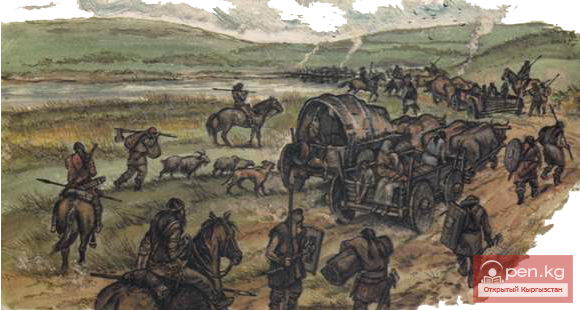
Kyrgyz-Gyangu
The earliest mention of the Kyrgyz under the Chinese name “gyan-gun”, “heguni”, or “jianggun”, dates back to 201 BC. The ancient tribes of heguni are listed among other nomads conquered in Central Asia by the Xiongnu chanyu Modu (Bichurin, 1998, p. 51). In other Chinese sources from the late 1st millennium BC to the first half of the 1st millennium AD, they were referred to by various names: “gegu”, “zegu”, “juyou”, and others (Kyuner, 1961, p. 55). The ancient Kyrgyz are repeatedly mentioned alongside the “dinlins”, prompting scholars to attempt to reconstruct the ethnic history of both peoples in their interactions. As early as the mid-19th century, N.Ya. Bichurin, who first translated information about the ancient and medieval nomadic peoples of Central Asia from Chinese dynastic histories, suggested that the “dinlins” lived in Siberia, on lands “from the Yenisei eastward to Baikal, on the left bank of the Angara” (Bichurin, 1998, p. 51, Note 1). The German sinologist W. Schott identified the “true Kyrgyz” with the population of Southern Siberia (Schott, 1864, pp. 432-461).
During the same period, V.V. Radlov undertook an attempt to study the “Kyrgyz graves” in the valley of the Abakan River (Radlov, 1989, p. 456). In the late 1920s, V.V. Barthold suggested that in ancient times the Kyrgyz-Gyangu might have lived in the area of Lake Kyrgyz-Nur in northwestern Mongolia (Barthold, 1963, p. 477). Subsequently, researcher S.V. Kiselev proposed a hypothesis about the formation of the Tashlyk culture of the “dinlin-gyaungun tribes” on the Yenisei (Kiselev, 1949, pp. 267, 268). This assumption was supported by L.R. Kyzlasov, who claimed that the Xiongnu, having conquered the “domain” of the dinlin-tagar, partially displaced them to the north, while the remaining dinlins, mixing with the “gyangu newcomers, laid the foundation for a new era - the Tashlyk era” (Kyzlasov, 1960, p. 162).
This hypothesis gained wide acceptance among specialists in the archaeology of Southern Siberia, although some noted that Chinese reports about the dinlins cannot refer only to the Minusinsk Basin, as these tribes lived over a very wide territory of Central Asia (Savinov, 1984, pp. 12, 13).
Some archaeologists expressed doubts about the identification of the bearers of the Tashlyk culture with the gyangu (Vadetskaya, 1999, pp. 178-181). L.A. Borovkova clarified the areas of residence of the dinlins and gyangu in the Xiongnu-Xianbei era within Eastern Turkestan based on Chinese sources (Borovkova, 1989, p. 62).
At the beginning of the 1st century BC, the dinlins still remained under the subjugation of the Xiongnu. It is likely that the gyangu were in a similar position. By the order of the Xiongnu chanyu, their ruler, “dinlin-wang”, was appointed a defector from China, Wei Lüy, who came from the nomads known as “huszi”, who were at that time under the rule of the Han Empire. At the same time, a captured Chinese general, Li Ling, was accepted into the Xiongnu service and appointed “yuxiao-wang” (Taskin, 1973, p. 116). The Yenisei Kyrgyz believed that their ruling lineage descended from this captured Han general. Members of the Tang dynasty, who traced their lineage to Li Guangli, a senior relative of Li Ling, recognized these kinship ties and even attempted to build allied relations with the Kyrgyz Kaganate (Khudyakov, 2003, p. 176).
After the collapse of the Xiongnu confederation into two hordes, one of them moved westward to Eastern Turkestan. During this campaign, the Xiongnu conquered several tribes, including the gyangu. During the campaign, the Xiongnu army arrived in the habitats of the Usuns, who were located in the Tian Shan region. After some time, the Xiongnu horde of chanyu Zhizhi moved westward, where it was defeated and ceased to exist (Borovkova, 1989, p. 61).












































